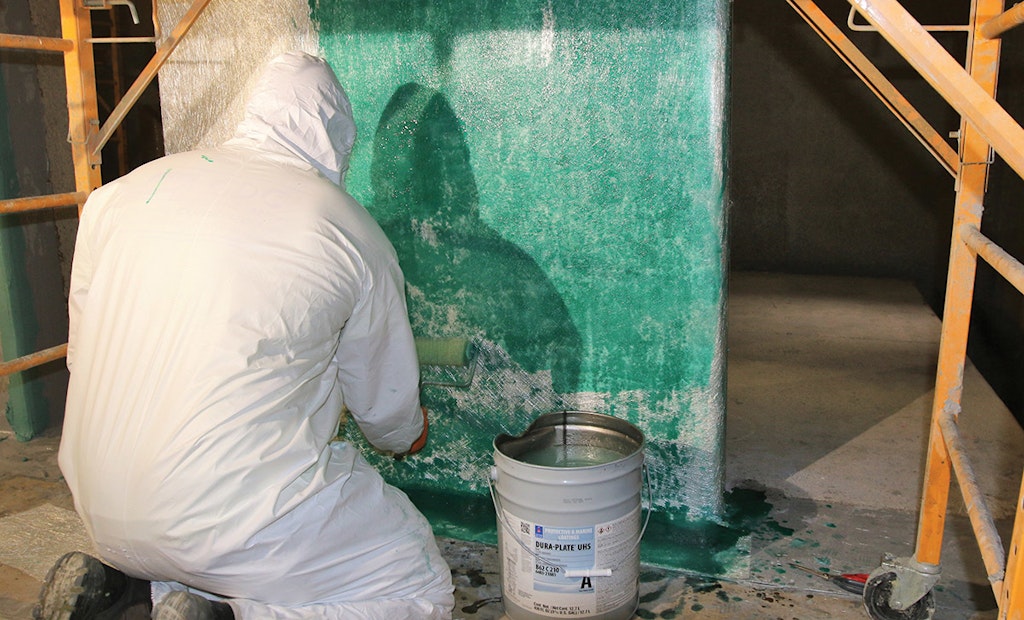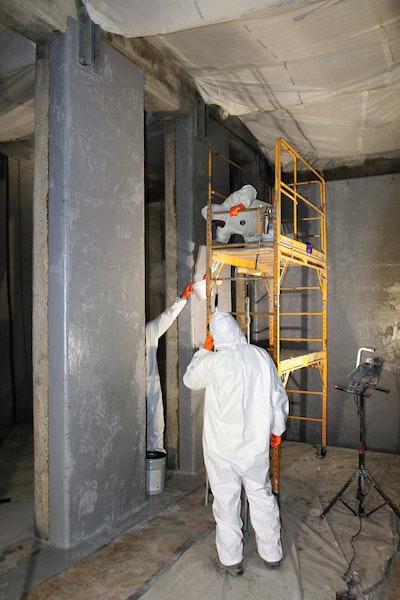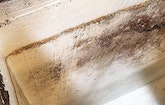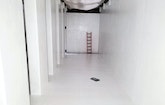
Applicators sealed in a 1.5-ounce fiberglass mat using a green-tinted laminate epoxy as part of the lining’s reinforcement layer.
Interested in Maintenance?
Get Maintenance articles, news and videos right in your inbox! Sign up now.
Maintenance + Get AlertsWater treatment facility owners have an array of protective coating options available for lining new concrete basins. However, they can opt to skip the lining altogether — at least at first.
Over time, unlined concrete is sure to deteriorate and will eventually need a lining; the decision to skip lining during construction basically kicks the paint can down the road. Robust concrete restoration materials and durable lining systems can easily restore basins to like-new condition, making the decision to wait perfectly sound, although owners must prepare to add a lining sometime in the future.
Such was the case for the Jordan Basin Water Reclamation Facility in Bluffdale, Utah. Before the facility opened in 2012, project managers from the South Valley Sewer District chose to not line the eight concrete basins that make up the facility’s membrane bioreactor. Facing budget restrictions, they planned to earmark future funds for lining after the concrete degraded from use.
MULTIPLE COATINGS
The deterioration came a bit faster than anticipated, as the corrosive membrane filter cleaning process caused the loss of 0.25 to 0.75 inches of concrete throughout the basins within about six years. There was no question the time to line the basins had arrived.
The district staff worked with Bowen Collins & Associates as design engineer for the lining project and with the Corrosion Control Technologies engineering firm to define the project parameters.
Utah-based CDC Restoration & Construction then completed the work, restoring the basins to like-new condition with a durable, nonpermeable lining system from Sherwin-Williams Protective & Marine. The labor-intensive 57-week project used a traditional five- to six-coat lining system while the facility remained in service.
The facility’s MBR technology prepares wastewater effluent for reuse in irrigation. The MBR removes mineral salts, iron, insoluble organics and biological matter from influent. Concrete in the basins had severely degraded from attack by citric acid and sodium hypochlorite used to remove contaminants from the MBR filters.
The chemicals had progressively eaten away at the unlined basin walls. CDC Restoration & Construction performed a variety of rehabilitation steps, including preparing the concrete for repairs, restoring its surface to its original plane, applying a moisture remediation primer, adding a fiberglass mat-reinforced epoxy laminate and applying a protective epoxy lining.
STEP BY STEP
The basins were restored one at a time while the facility remained in operation. Crew members set up a full containment system to keep dust and debris from contaminating adjacent basins. They also minimized dust and debris production by vapor-abrasive blasting the concrete.
Applicators first blasted the concrete to create a clean surface for coatings. Because operating basins remained full of water, project engineers knew moisture could migrate through the concrete on at least one wall in each basin under repair, creating potential adhesion issues.
To mitigate that problem, they spray-applied Resuprime MVT on the basin walls. This two-component, fast-curing epoxy resin is tolerant of residual moisture in concrete. It blocked moisture from migrating to the surface, enabling applicators to restore the concrete and apply the lining system.
FIXING FLAWS
About 12 hours after applying the moisture-control coat, applicators repaired the deteriorated concrete. Using Steel-Seam FT910, a 100% solids epoxy patching and surfacing compound, they repaired cracks; filled voids, bugholes and honeycombs; and rebuilt the deteriorated surfaces to their original dimensions.
Because some basin walls had been previously primed and filled with epoxy cementitious materials, engineers specified the surfacing compound instead of a traditional cementitious resurfacer or mortar. The previously applied materials would not permit strong adhesion for a cementitious resurfacer or mortar.
The Steel-Seam surfacing compound application was also more efficient than alternative technologies. For example, applying urethane cement with a trowel would have required days of labor-intensive work and a longer project schedule.
With the concrete built back to an even plane, applicators turned to the reinforced lining system. They first applied a base layer of Dura-Plate UHS Clear Laminate and topped that with a 1.5-ounce fiberglass mat. Next, they sealed the mat with more of the clear laminate material before top-coating it with Dura-Plate UHS Epoxy White.
Both of these ultra-high-solids epoxy amine coatings are designed as laminating systems in immersion service. They provide reliable protection with high-build, edge-retentive properties.
COLOR-AIDED INSPECTION
Ensuring quality lining installations is important when applying layered laminate/fiberglass mat systems. The base layer must be fully adhered to the substrate, and that requires the fiberglass layer to be fully wetted out. Otherwise, adhesion failures are likely.
For quality control, the engineering team devised a solution that would help inspectors both during the lining application and later when examining the lining for damage during periodic service inspections.
When clear laminate products are used, it is difficult to confirm visually that the fiberglass matting is fully saturated because there is no contrasting color. Therefore, the engineers specified a phthalo green hardener with the clear epoxy resin. The green tinting made it easier for applicators and inspectors to make sure the fiberglass matting was fully wetted simply by looking for any areas that were still white or a lighter shade of green.
Then, as applicators installed the white topcoat, they were able to ensure a uniform, pinhole-free final film by fully covering the contrasting green layer. Any areas of green showing through could quickly be touched up. This full coverage left no air pockets, dry areas or voids between the concrete and fiberglass, minimizing potential for adhesion issues.
The color contrast also helped inspectors examine the basins after service, since any visible green spots would indicate damage to the topcoat.
BACK IN BUSINESS
After inspection by staff from Bowen Collins engineers, each basin was approved for use before applicators moved on to the next one. The protocol of applying the moisture-mitigation coat, surfacing compound, tinted base epoxy layer and white topcoat enabled the work to proceed quickly. The team restored all eight basins well within the 60-week target completion time.
The 15 mgd facility has remained in operation throughout the project, serving the surrounding area with filtered water for irrigation. The team’s work earned first place in the 2020 Sherwin-Williams Impact Awards program.
ABOUT THE AUTHOR
Greg Hansen (greg.l.hansen@sherwin.com) is project development manager for Sherwin-Williams Protective & Marine, focused on engineering for the power, water and wastewater, and food and beverage markets.








